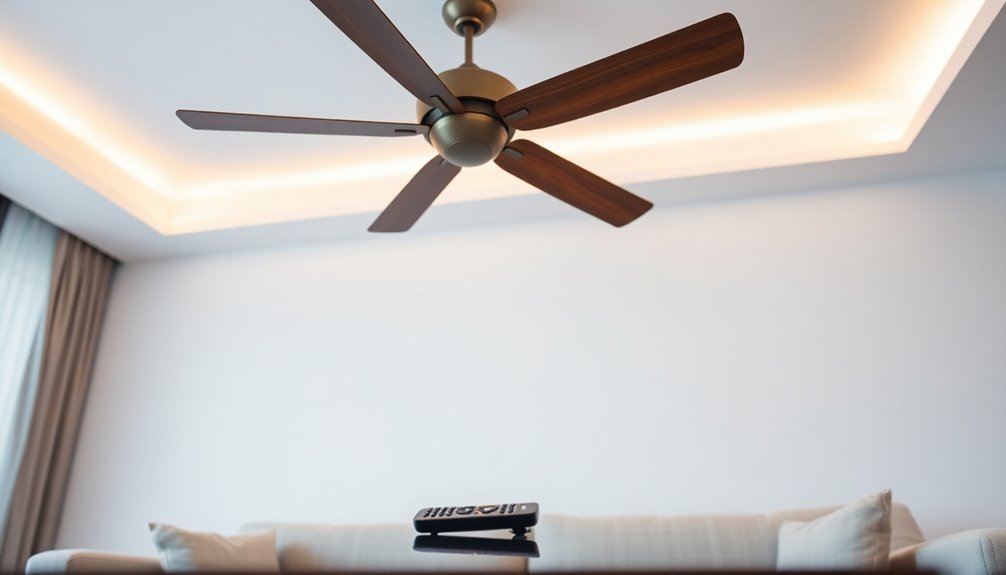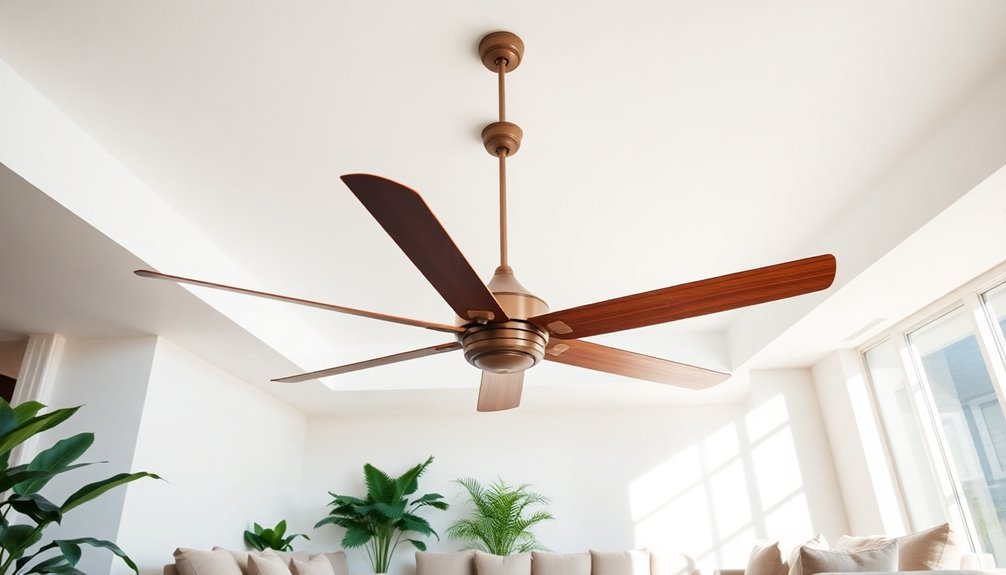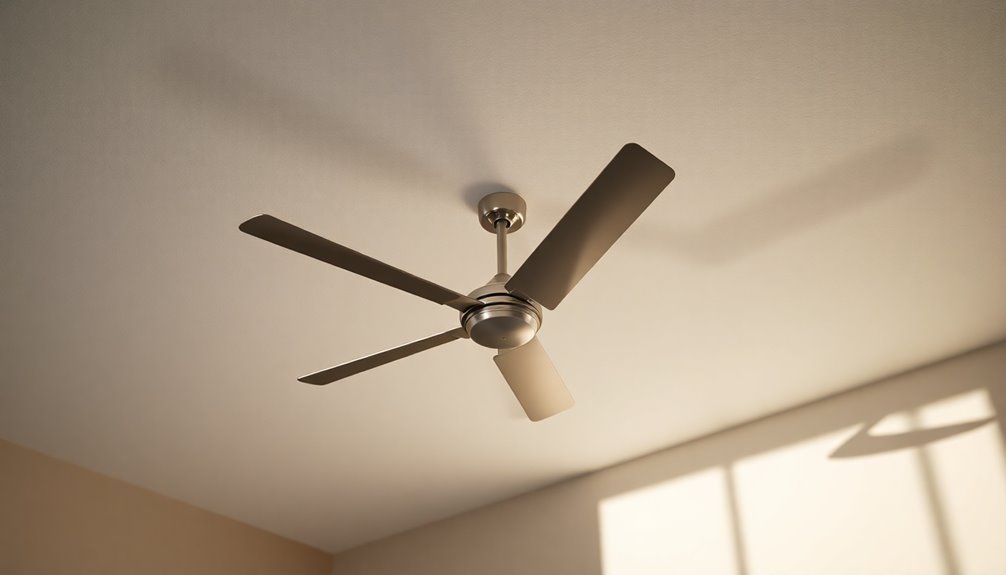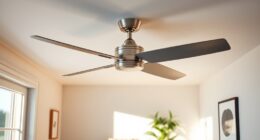To determine the right size ceiling fan for your space, first measure the room's square footage. For rooms up to 75 sq ft, choose a fan with a blade span of 29-36 inches. If your room is between 75-175 sq ft, go for a 42-48 inch fan. For larger rooms (175-350 sq ft), select a fan with a blade span of 52-56 inches. If your space exceeds 350 sq ft, you'll need a fan 60 inches or wider. Proper sizing guarantees effective airflow and ideal comfort. There's more to take into account, so let's uncover additional details to help you out.
Key Takeaways
- Measure your room's square footage by multiplying length and width in feet to determine the appropriate fan size.
- For rooms up to 75 sq ft, choose a ceiling fan with a blade span of 29-36 inches.
- For medium rooms (75-175 sq ft), select a fan with a blade span of 42-48 inches for optimal airflow.
- Large rooms (175-350 sq ft) require fans with a blade span of 52-56 inches to ensure effective circulation.
- Extra-large spaces over 350 sq ft need fans with a blade span of 60 inches or wider for maximum comfort.
Ceiling Fan Sizing Guidelines

When choosing a ceiling fan, understanding sizing guidelines is vital for achieving ideal airflow in your space. First, you need to measure the square footage of your room.
For rooms up to 75 square feet, select a ceiling fan with a blade span of 29 to 36 inches for peak airflow. If your room falls between 75 and 175 square feet, look for fans with a blade span of 42 to 48 inches.
For larger spaces measuring 175 to 350 square feet, you'll want fans that boast a blade span of 52 to 56 inches to guarantee effective air circulation.
Finally, extra-large rooms exceeding 350 square feet require ceiling fans that are 60 inches or wider for adequate airflow and comfort.
Remember, matching the ceiling fan sizes to your room's dimensions is essential; incorrect sizing can lead to discomfort and inefficient air circulation.
Also, take into account your ceiling height, as it can influence the ideal height for your fan installation. Following a ceiling fan size guide will help you make the best choice for your specific needs.
Measuring Room Dimensions

Accurately measuring your room dimensions is essential for selecting the right ceiling fan size. Start by measuring the length and width of your room in feet. Multiply these two numbers to calculate the square footage. This measurement will guide you in choosing the appropriate fan size for your space.
For small rooms up to 75 square feet, a fan size of 29 to 36 inches is recommended. If your room falls between 75 and 175 square feet, take into account a fan sized 42 to 48 inches. For larger areas, a fan with a span of 52 to 56 inches works well for rooms ranging from 175 to 350 square feet, while fans 60 inches or wider are ideal for spaces exceeding 350 square feet.
When measuring for fan size, don't forget to take into account architectural features or furniture that might impact airflow. Proper placement maximizes comfort and efficiency.
If you're dealing with an L-shaped room, divide the area into rectangles, calculate the square footage for each section, and add them up to find the overall room size for accurate fan sizing. This way, you'll guarantee you choose the right size fan for the best airflow.
Selecting Ideal Blade Span

Choosing the right blade span for your ceiling fan is essential for achieving ideal airflow in your space.
First, consider your room size. For rooms up to 75 square feet, you'll want a ceiling fan with a blade span of 29 to 36 inches to guarantee excellent airflow.
If your space ranges from 75 to 175 square feet, select the right size fan with a blade span of 42 to 48 inches for effective air circulation.
For larger rooms between 175 to 350 square feet, choose fans with a blade span of 52 to 56 inches to maximize comfort and airflow.
In extra-large living areas over 350 square feet, look for ceiling fans that have a blade span of 60 inches or wider to accommodate the greater space.
Understanding Ceiling Fan Height

When it comes to ceiling fan height, you need to take into account several factors to guarantee safety and efficiency.
Aim for a fan height of at least 7 feet from the floor, and bear in mind the clearance requirements and downrod length for your specific ceiling type.
Proper installation not only enhances airflow but also keeps your space looking great.
Ideal Fan Height
Finding the ideal height for your ceiling fan is essential for ensuring both safety and airflow efficiency. Here are some key points to evaluate:
- Install the fan at least 7 feet above the floor for safety.
- Use flush mount ceiling fans for ceilings lower than 8 feet.
- Maintain a clearance of 12-14 inches between the fan blades and the ceiling.
- For ceilings higher than 9 feet, longer downrod lengths bring the fan down to the ideal fan height of about 8 feet.
- Always measure the height of your ceiling accurately before installation.
Ceiling Clearance Requirements
Ceiling clearance is vital for the effective operation of your ceiling fan and your safety. To guarantee peak airflow, install your fan at least 7 feet above the floor. This height provides the minimum clearance necessary for safe movement beneath the fan.
Additionally, maintain at least 8 inches between the fan blades and the ceiling for effective air circulation.
If your ceilings are lower than 8 feet, consider flush mount fans. These designs help maximize headroom while still providing adequate airflow.
For standard ceiling fans, you typically need 12-14 inches of clearance above the fan blades for proper function and air movement.
Using a downrod can help achieve the ideal height, allowing the fan to hang approximately 8 feet from the floor to the blades. This configuration guarantees that you benefit from both efficient air circulation and a safe environment.
Remember, meeting these ceiling clearance requirements is vital not just for performance but also for preventing accidents.
Downrod Length Considerations
To guarantee ideal airflow and safety, understanding downrod length is vital for high ceilings. When your ceiling is higher than 9 feet, using a downrod becomes essential to achieve the best height for your ceiling fan. Here are some key considerations:
- A typical fan housing measures 8 to 12 inches, so account for this in your downrod length.
- For a 10-foot ceiling, a 12-inch downrod lets fan blades hang about 8 feet above the floor.
- Always maintain a minimum clearance of 12 inches from the fan blades to the nearest wall.
- Reference charts can simplify matching ceiling heights to appropriate downrod lengths.
- Proper installation guarantees effective airflow and enhances safety.
When choosing a downrod length, aim for that 8-foot height for the fan blades. This positioning not only improves airflow but also keeps your space safe from potential hazards.
Consider your ceiling height and the necessary clearance to make sure your fan operates effectively. By paying attention to these details, you'll enjoy comfortable air circulation and peace of mind in your home.
Mounting Options for Fans

When selecting a ceiling fan, the mounting option plays an important role in guaranteeing ideal performance and comfort. You'll find several mounting styles available, each suited for different ceiling heights.
If your ceiling is under 8 feet, flush mount fans are your best bet as they sit directly against the ceiling, maximizing headroom and providing a sleek look. For ceilings higher than 9 feet, downrod mount fans are preferable since they lower the fan closer to your living space, enhancing airflow.
It's vital to maintain at least 7 feet of clearance from the floor for safety and peak performance. Standard-mount fans require 12-14 inches of space from the ceiling, while flush-mount fans need around 6-10 inches above the blades.
If you're dealing with an angled ceiling, consider using an angled-ceiling adapter to guarantee proper installation and airflow efficiency; these are compatible with longer downrods.
Selecting the right mounting hardware is important to your fan's function, so take your ceiling height and the necessary clearance into account to find the best fit for your space.
Calculating Downrod Length

When you're figuring out the right downrod length for your ceiling fan, start by measuring your ceiling height.
You want the fan blades to sit about 8 feet off the floor for maximum airflow.
Keep in mind that the height of the fan housing also affects your total downrod length, so factor that in as you decide.
Downrod Length Guidelines
Choosing the right downrod length is essential for guaranteeing your ceiling fan operates effectively and safely. To achieve the best air circulation, you need to take into account several factors:
- Ceiling height: Taller ceilings require longer downrods.
- Fan housing: This typically adds 8-12 inches to the overall height.
- Ideal height: Aim for the fan blades to be about 8 feet off the floor.
- Clearance: Maintain at least 7 feet of clearance for safety.
- Fan placement: Proper positioning guarantees efficient airflow.
To determine the appropriate downrod length, subtract the height of the fan housing from your ceiling height. For example, if you have a 10-foot ceiling, a 12-inch downrod will position the fan at the perfect 8-foot height above the floor.
Following downrod guidelines helps you achieve the perfect balance between functionality and safety. Reference charts are available that suggest specific downrod lengths based on various ceiling heights, guaranteeing you find the best fit for your space.
Ceiling Height Considerations
Understanding ceiling height is vital for calculating the right downrod length for your ceiling fan. If your ceiling height exceeds 9 feet, using a downrod is recommended to guarantee ideal air circulation and comfort.
The standard clearance for ceiling fans is at least 7 feet above the floor, which is important for safety and effective airflow.
When determining the appropriate downrod length, consider the height of the fan housing, typically measuring between 8 to 12 inches. For instance, with a 10-foot ceiling, a 12-inch downrod is suitable. This configuration allows the fan blades to sit at around 8 feet, maintaining the necessary clearance to maximize airflow.
Always refer to available charts that help you determine the appropriate downrod length based on your specific ceiling height and fan mounting needs.
Fan Airflow and Efficiency

To guarantee ideal comfort in your space, it's crucial to take into account ceiling fan airflow and efficiency. The effectiveness of your fan largely depends on its CFM rating, which measures airflow in cubic feet per minute. For best cooling, match the CFM rating to your room dimensions.
Here's what to bear in mind:
- Smaller rooms (up to 75 sq. ft.) typically need a fan with a CFM of 1,000 to 2,000.
- Larger spaces (over 350 sq. ft.) may require fans with CFM ratings exceeding 8,000.
- The blade pitch impacts airflow efficiency; a pitch of 12 to 15 degrees is ideal for maximizing performance.
- Seasonal blade rotation can enhance airflow; reversing the direction in winter helps circulate warm air.
- Choosing the right ceiling fan size not only boosts airflow but also promotes energy savings.
Improper fan sizing can lead to increased electricity usage and discomfort.
Motor Types and Performance

When choosing a ceiling fan, understanding motor types can greatly impact your decision.
AC motors are common and offer reliable performance with simple installation, while DC motors are more efficient and consume less energy.
AC Motor Advantages
AC motors are a popular choice for ceiling fans, thanks to their economical pricing and straightforward installation process. When you're looking for a fan that meets standard applications without breaking the bank, AC motors are often the go-to option.
Here are some key advantages:
- Budget-friendly: Lower upfront costs make AC motors accessible for most consumers.
- Ease of installation: Their design allows for quick and simple setup, perfect for DIY projects.
- Three speed settings: You can easily choose the airflow that suits your needs.
- Energy efficiency: While they may not be as efficient as DC motors, they still perform well for everyday use.
- Higher noise level: Be mindful that AC motors can be noisier, which might affect noise-sensitive areas.
While the long-term use of AC motors may lead to higher energy consumption, their benefits in price and installation make them attractive for many homes.
Just keep in mind the noise level if you're placing your ceiling fan in a quiet space. Overall, AC motors provide a solid blend of performance and value for your ceiling fan needs.
DC Motor Efficiency
DC motors stand out for their impressive energy efficiency, consuming up to 70% less energy than traditional AC motors while still providing comparable airflow. This means you can enjoy a comfortable environment without greatly increasing your energy costs.
With a wider range of speed settings, DC motors offer superior airflow control, allowing you to adjust the fan according to your specific needs and preferences.
One of the key benefits of DC motors is their quiet operation, making them perfect for quiet environments like bedrooms and offices. You won't have to worry about disruptive noise while you work or sleep.
Additionally, many DC motor ceiling fans come equipped with remote controls and smart home compatibility, offering you added convenience in managing your space.
While the initial cost of a DC motor fan may be higher, the long-term energy savings can lead to lower utility bills, making it a cost-effective choice overall.
Investing in a DC motor ceiling fan not only enhances the comfort of your home but also contributes to more sustainable living, proving that efficiency and comfort can go hand in hand.
Installation Tips and Tricks

How can you guarantee a smooth installation of your ceiling fan? By following these essential tips, you'll enjoy ideal air circulation and safety:
- Always install your fan at least 7 feet above the floor for safety.
- Use a downrod ceiling fan for ceilings higher than 9 feet to provide a minimum of 8 inches of clearance between the blades and the ceiling, as downrods enhance fan performance by increasing airflow.
- For flush mount fans, maintain a distance of 12-14 inches from the ceiling to enhance airflow.
- Before installation, check the ceiling's structural integrity and verify the electrical box is suitable, as a metal box is typically needed for support.
- Always refer to the manufacturer's instruction manual for specific installation guidelines and safety precautions.
Taking these steps will help you achieve effective air circulation while confirming your ceiling fan is securely installed. Additionally, ensure you consider the room size when selecting your ceiling fan, as it plays a crucial role in determining the appropriate fan size and power.
Remember, the right height and clearance can make all the difference in performance.
By adhering to these recommendations, you can enjoy a comfortable environment while avoiding potential hazards.
Happy installing!
Maintenance and Care for Fans

After guaranteeing a smooth installation, maintaining your ceiling fan is vital to keeping it running efficiently and safely. Regular maintenance helps improve airflow and prolongs the life of your fan.
Start by cleaning the fan blades and motor housing with a damp cloth to eliminate dust and dirt. This simple step can greatly boost performance.
Next, inspect the fan's electrical connections and mounting hardware at least once a year. This confirms everything is stable and safe during operation.
Don't forget to lubricate the fan motor as per the manufacturer's recommendations; it's critical for smooth operation.
Check the fan blades for any signs of damage or warping. Damaged blades can negatively impact performance, so replace or adjust them if necessary.
Additionally, if your fan wobbles during operation, it's important to balance the blades. You can do this by adding weights to the lighter blades to guarantee even distribution.
Frequently Asked Questions
Is a 52 Inch Fan Too Big for a 12X12 Room?
Yes, a 52-inch fan is too big for a 12×12 room.
When you use a fan that size, you might create excessive airflow, making the space feel drafty and uncomfortable. It can also lead to higher energy costs since it uses more power than necessary.
Instead, you should consider a fan between 36 to 42 inches for ideal airflow and comfort, ensuring your room stays cozy and energy-efficient.
What Size Room for a 52 Inch Ceiling Fan?
You might think a 52-inch ceiling fan is too big for your space, but it's actually perfect for medium to large rooms.
For areas ranging from 225 to 400 square feet, this fan delivers excellent airflow and comfort. It works wonders in living rooms, large bedrooms, and media rooms, ensuring you stay cool and relaxed.
Just make sure there's enough clearance and distance from the walls to maximize its efficiency and safety.
Is It OK to Oversize Ceiling Fan?
It's generally not a good idea to oversize a ceiling fan.
If you choose a fan that's too large for your space, you might create an uncomfortable draft and increase your energy bills.
Additionally, a big fan can overwhelm a small room, disrupting its aesthetic.
Sticking to recommended sizes for your room dimensions guarantees ideal airflow and keeps your space comfortable and visually appealing.
Always consider both function and style when selecting a fan.
What Size Room for a 60 Inch Ceiling Fan?
Imagine a gentle breeze dancing through your space, bringing life to every corner.
A 60-inch ceiling fan shines in rooms over 350 square feet, like a captain steering a ship through open waters.
If your area's between 175 to 350 square feet, it might feel a bit like wearing a big coat in summer.
Make sure you maintain at least 12 inches from walls for best airflow, allowing the breeze to flow freely and refresh your surroundings.
Conclusion
Choosing the right ceiling fan is like finding the perfect partner—it should fit your space, style, and needs. By measuring your room, selecting the right blade span, and considering mounting options, you'll create a comfortable oasis. Don't forget about airflow, motor performance, and maintenance to keep your fan running smoothly. With the right fan, you'll not only beat the heat but also enjoy a revitalizing breeze that brings your home to life.









